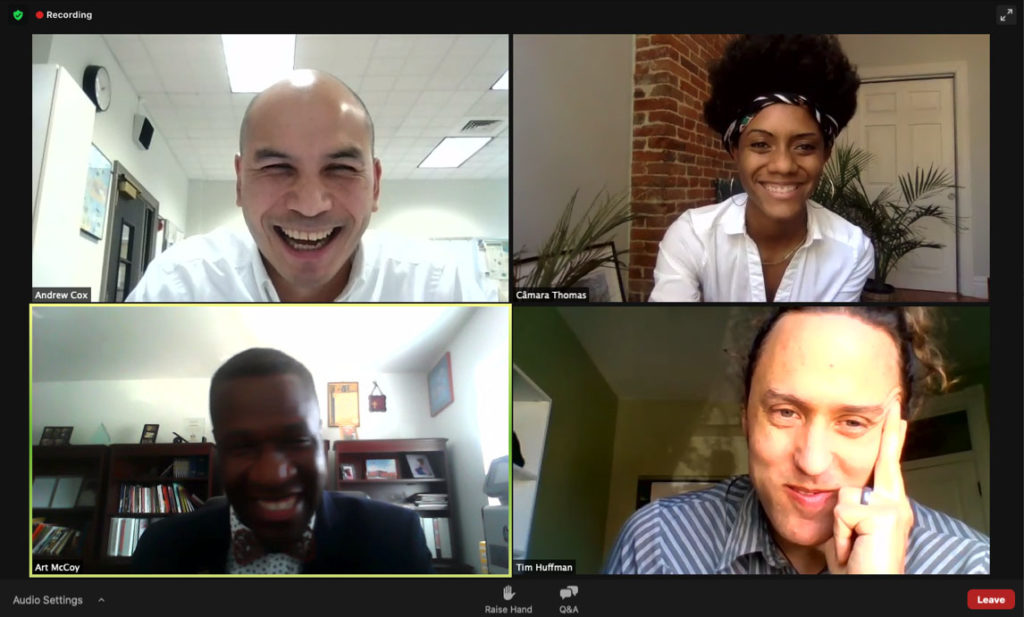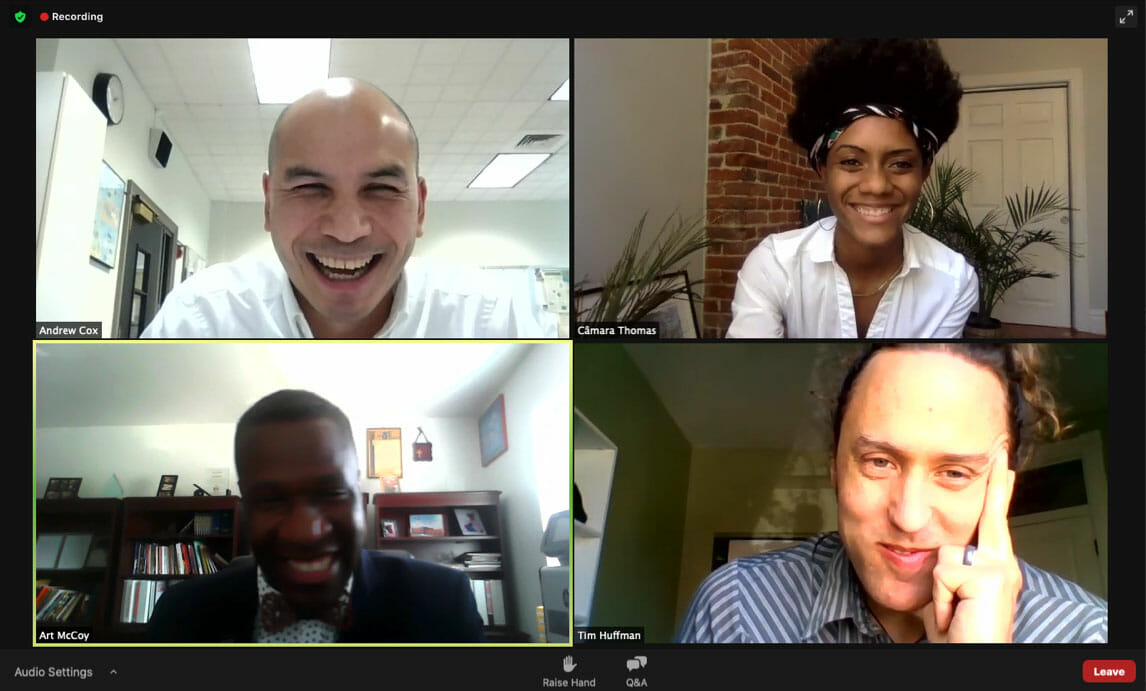Eleventh grade history students gathered online for the latest panel discussion for their History of St. Louis course, and this session’s topic was on the social and cultural issues in our community. We welcomed Cami Thomas ’11, a documentary filmmaker, Dr. Art McCoy, the Superintendent of Jennings School District, and Dr. Tim Huffman, Associate Professor at St. Louis University. Andy Cox, Upper School History Teacher, moderated the discussion.

Panelists began by introducing themselves and then tackling the question: What do you think are the most important social and cultural issues for St. Louis right now? Thomas began by expressing her love for her home city and admitting that there are, unfortunately, a lot of issues. She focused on the inequity she sees throughout the city, which she experienced as a student at MICDS. “Going to school in one part of the city, living in another part, and seeing still other parts through volunteer work with my family, there are stark differences,” she said. Thomas referenced the extremes she has witnessed, sharing that “There’s not a lot of middle ground, which sets people up so even if you want to do well and do better for yourself and your community, if you are starting at the extreme, it’s hard.”
McCoy spoke about the importance of reflection. “The most important social and cultural issue right now…is knowing who we are, knowing our role in where we are and where we’re going, and knowing what basic rights and privileges everyone should have.” He summed up his thoughts by saying that dismantling oppression is the most important issue in both St. Louis and in our country right now.
How does St. Louis leverage its assets to improve the challenges that our region faces? How do we make things better? Thomas said that it always comes down to money and how we move it from the organizations and people who have it to the people who need it. She pointed out that St. Louis has very popular- and profitable – sports teams, but there are people struggling to eat, or to find a job while dealing with daycare or transportation issues. She recommends working on a system that funnels resources directly to those who need them. “Buy groceries for someone. Buy gas. Leverage your own assets, personal resources, passion, or energy, and learn where you can help and where you can donate,” she said. Thomas spoke about the large corporations headquartered in St. Louis and the thriving start-up scene, all of which bring in more money and innovation. “If it [money] comes here but only stays in a few bubbles, what does it actually do?”
She shared an experience of being held up at gunpoint where she thought she was going to lose her life. “It made me think, ‘What do you need? What do you actually need that you’re trying to take from me?’” She realized that the person who threatened her may very well be in a situation where they thought armed robbery was the only way they could provide for themselves and their loved ones. She realized that we, as a society, must do a better job of figuring out how to get help to the people who need it most so they don’t take situations into their own hands. Thomas spoke about Mazlow’s hierarchy of needs, saying, “When the basic needs are taken care of, people have freedom to imagine and create and think about what they want to do. That’s when you get a vibrant city. That’s the version of St. Louis I want to see.”
Students responded to Thomas’ thought about looking deeper into these issues. Jack Niedringhaus ’22 said, “Obviously, we can’t change the past, but in the present, we can change the future.”
Dr. Tim Huffman researches homelessness and how it affects people and society. “Homelessness is a complicated thing,” he said. “It’s a profound history connected to many social inequities.” He talked about how restrictive and racist housing laws in St. Louis created ongoing issues with intergenerational wealth, and how inequity in policing and economic development impact housing. “Homeownership has a profound effect across generations,” he said. “Untreated substance use disorder, radical health disruption, job loss, family moving around…it’s hard to make it in the United States if two or three things go wrong in your life at the same time.” In his work, Huffman connects with communities and asks questions to help us move toward the greater good. “I volunteer, learn the community, meet people, and in the course of that engagement, identify questions that the community has for itself and then bring the knowledge I have as a professor to help them engage. Don’t just volunteer; volunteer in the way that develops you and calls on your greatest skills.”
How can St. Louis and its citizens leverage themselves to make this a better region? How should students channel their energy? McCoy said it’s important for students to know who they are in this moment, and where they are going, so they can help be a part of where they are going. “We are not just being, we are becoming,” he said. “As we do more, we become more. It’s important to have resources because a dream without resources is just a hallucination.” He said we should work to make rioting unnecessary. “If rioting is the language of the voiceless,” McCoy said, quoting Martin Luther King Jr., “give voice to someone you don’t know, who isn’t in your circle of influence, who you can help, and who you can provide needs for. Expand your sphere of interaction beyond your family.” He then explained something he shares through the community: I SEE U.
I = Inclusion.
S = See: Observe others for their inner selves, not just their outer appearances.
E = Engagement: Do something with others not like you, such as work, eat, and play with them.
E = Empathize: Feel what they feel, and try to know what they know.
U = Understand: Find some common ground.
“Equity is what loves looks like in public among strangers,” said McCoy. “It’s meeting the need at the speed of the need. Love becomes action and an allocation of resources that we give because we all benefit.”
Thomas was asked, “How does your work fit into the larger context and how do you see yourself moving forward? How do you see your role and impact in the business world and as an artist?” She spoke about her time in the business world, at companies like Tesla and Red Bull. She said those experiences taught her to be organized, how to be an effective artist, and how to implement change. She’s hoping to show the tangible difference she can make as an artist, and is striving to build a production company where “every single thing I do or create has to have some type of community tie.” She already does this partially now, and pays attention to what she feels led toward, what makes her happy, fulfilled, and connected to the community. “It’s a flow of how do I fit into this community and this world…in a way that’s not disruptive but helpful. A lot of the work I do is behind the scenes. I like to tell the stories of others.” She’s also staying focused on helping others, “making sure the ladder is still there for other people and pulling people up as I go, because other people did that for me. I want to pour resources, pour love and tenderness into the place that molded and built me, which is St. Louis.”
Cox then asked Huffman, “How has COVID impacted your work at the university or working with your community of people who are homeless or in precarious situations?” Huffman replied that the pandemic has changed everything, and he’s proud of how St. Louis University has handled the challenge. He spoke about how many organizations who may have said that accommodations couldn’t be done have now transitioned to working from home. “The greatest lesson of COVID is that if the will exists, we can make it work.” While Zoom is not the solution to everything, it does become a useful tool that can be used even when the pandemic is over. He touched on the difficulty many nonprofits faced in working to reconfigure their systems to deal with the pandemic, such as increasing the number of homeless shelters and forging new alliances. While it’s not easy to gather perfect data, he believes there have been no fatalities from COVID-19 in local homeless shelters.
Huffman then told students that the pandemic, which brought the vast implementation of video calls, offers new opportunities. “We’re in a weird world where if you email someone and say, ‘I like your initiative. Do you mind if I join your Zoom meetings?’ that is a thing that is possible. As a young person, you can align yourself with communities and be a contributor all over the world. You’re no longer constrained by not having a car or parents not letting you out after 7. In a weird way, communities are more accessible now than they’ve ever been, if you’re willing to do digital engagement.”
“The speakers shared a unique perspective of their own experience and the experience of others which definitely shaped how I think about St. Louis. Additionally, I really liked Dr. Huffman’s point that better than the question of ‘what does the world need’ is the question ‘what can I do for the world?’ We all have different interests and talents, so there are many unique and creative ways to help others and improve a situation,” said Cate Cody ’22.
Xavier Asher ’22 reflected on what he heard from the panelists. He said, “It made me very optimistic about the city’s future. Of course, the city has a lot of problems, but they were all so passionate about making positive change that I couldn’t help but think that St. Louis is going to be in a better place in a few years.” Alex Winski ’22 agreed. “The panelists mentioned how much inequity and inequality exists in St. Louis; this changed my idea of the city yet gave me hope, as each of the panelists had practical solutions.”
Our students appreciated the vibrant discussion from our panelists. Thank you to Cami Thomas ’11, Dr. Art McCoy, and Dr. Tim Huffman for sharing their time and thoughts with our community.
